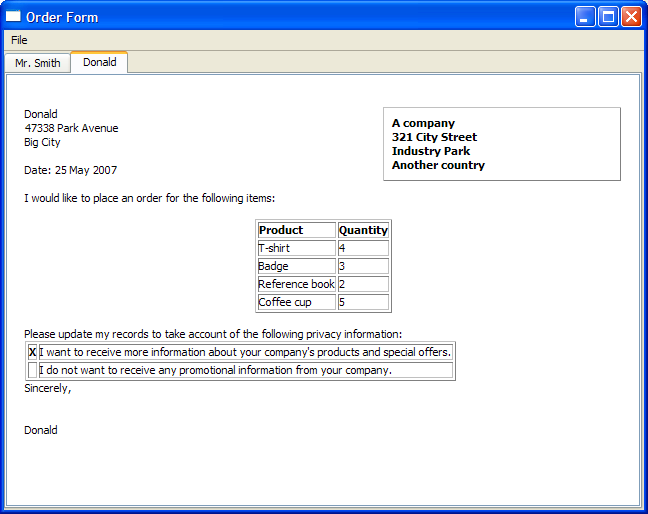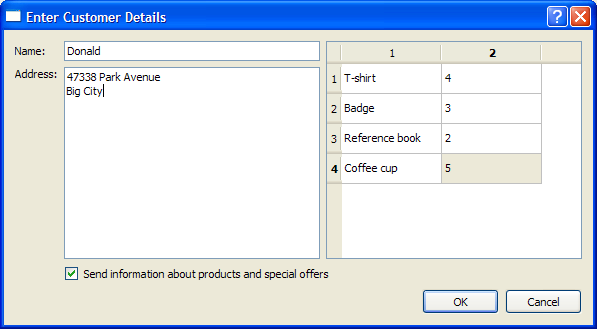Order Form Example¶
The Order Form example shows how to generate rich text documents by combining a simple template with data input by the user in a dialog.
The Order Form example shows how to generate rich text documents by combining a simple template with data input by the user in a dialog. Data is extracted from a
DetailsDialogobject and displayed on aQTextEditwith aQTextCursor, using various formats. Each form generated is added to aQTabWidgetfor easy access.
DetailsDialog Definition¶
The
DetailsDialogclass is a subclass ofQDialog, implementing a slotverify()to allow contents of theDetailsDialogto be verified later. This is further explained inDetailsDialogImplementation.class DetailsDialog : public QDialog { Q_OBJECT public: DetailsDialog(const QString &title, QWidget *parent); public slots: void verify(); public: QList<QPair<QString, int> > orderItems(); QString senderName() const; QString senderAddress() const; bool sendOffers(); private: void setupItemsTable(); QLabel *nameLabel; QLabel *addressLabel; QCheckBox *offersCheckBox; QLineEdit *nameEdit; QStringList items; QTableWidget *itemsTable; QTextEdit *addressEdit; QDialogButtonBox *buttonBox; };The constructor of
DetailsDialogaccepts parameterstitleandparent. The class defines four getter functions:orderItems(),senderName(),senderAddress(), andsendOffers()to allow data to be accessed externally.The class definition includes input widgets for the required fields,
nameEditandaddressEdit. Also, aQCheckBoxand aQDialogButtonBoxare defined; the former to provide the user with the option to receive information on products and offers, and the latter to ensure that buttons used are arranged according to the user’s native platform. In addition, aQTableWidget,itemsTable, is used to hold order details.The screenshot below shows the
DetailsDialogwe intend to create.
DetailsDialog Implementation¶
The constructor of
DetailsDialoginstantiates the earlier defined fields and their respective labels. The label foroffersCheckBoxis set and thesetupItemsTable()function is invoked to setup and populateitemsTable. TheQDialogButtonBoxobject,buttonBox, is instantiated with OK and Cancel buttons. ThisbuttonBox‘saccepted()andrejected()signals are connected to theverify()andreject()slots inDetailsDialog.DetailsDialog::DetailsDialog(const QString &title, QWidget *parent) : QDialog(parent) { nameLabel = new QLabel(tr("Name:")); addressLabel = new QLabel(tr("Address:")); addressLabel->setAlignment(Qt::AlignLeft | Qt::AlignTop); nameEdit = new QLineEdit; addressEdit = new QTextEdit; offersCheckBox = new QCheckBox(tr("Send information about products and " "special offers")); setupItemsTable(); buttonBox = new QDialogButtonBox(QDialogButtonBox::Ok | QDialogButtonBox::Cancel); connect(buttonBox, &QDialogButtonBox::accepted, this, &DetailsDialog::verify); connect(buttonBox, &QDialogButtonBox::rejected, this, &DetailsDialog::reject);A
QGridLayoutis used to place all the objects on theDetailsDialog.QGridLayout *mainLayout = new QGridLayout; mainLayout->addWidget(nameLabel, 0, 0); mainLayout->addWidget(nameEdit, 0, 1); mainLayout->addWidget(addressLabel, 1, 0); mainLayout->addWidget(addressEdit, 1, 1); mainLayout->addWidget(itemsTable, 0, 2, 2, 1); mainLayout->addWidget(offersCheckBox, 2, 1, 1, 2); mainLayout->addWidget(buttonBox, 3, 0, 1, 3); setLayout(mainLayout); setWindowTitle(title); }The
setupItemsTable()function instantiates theQTableWidgetobject,itemsTable, and sets the number of rows based on theQStringListobject,items, which holds the type of items ordered. The number of columns is set to 2, providing a “name” and “quantity” layout. Aforloop is used to populate theitemsTableand thenameitem’s flag is set toItemIsEnabledorItemIsSelectable. For demonstration purposes, thequantityitem is set to a 1 and all items in theitemsTablehave this value for quantity; but this can be modified by editing the contents of the cells at run time.void DetailsDialog::setupItemsTable() { items << tr("T-shirt") << tr("Badge") << tr("Reference book") << tr("Coffee cup"); itemsTable = new QTableWidget(items.count(), 2); for (int row = 0; row < items.count(); ++row) { QTableWidgetItem *name = new QTableWidgetItem(items[row]); name->setFlags(Qt::ItemIsEnabled | Qt::ItemIsSelectable); itemsTable->setItem(row, 0, name); QTableWidgetItem *quantity = new QTableWidgetItem("1"); itemsTable->setItem(row, 1, quantity); } }The
orderItems()function extracts data from theitemsTableand returns it in the form of aQList<QPair<QString,int>> where eachQPaircorresponds to an item and the quantity ordered.QList<QPair<QString, int> > DetailsDialog::orderItems() { QList<QPair<QString, int> > orderList; for (int row = 0; row < items.count(); ++row) { QPair<QString, int> item; item.first = itemsTable->item(row, 0)->text(); int quantity = itemsTable->item(row, 1)->data(Qt::DisplayRole).toInt(); item.second = qMax(0, quantity); orderList.append(item); } return orderList; }The
senderName()function is used to return the value of theQLineEditused to store the name field for the order form.QString DetailsDialog::senderName() const { return nameEdit->text(); }The
senderAddress()function is used to return the value of theQTextEditcontaining the address for the order form.QString DetailsDialog::senderAddress() const { return addressEdit->toPlainText(); }The
sendOffers()function is used to return atrueorfalsevalue that is used to determine if the customer in the order form wishes to receive more information on the company’s offers and promotions.bool DetailsDialog::sendOffers() { return offersCheckBox->isChecked(); }The
verify()function is an additionally implemented slot used to verify the details entered by the user into theDetailsDialog. If the details entered are incomplete, aQMessageBoxis displayed providing the user the option to discard theDetailsDialog. Otherwise, the details are accepted and theaccept()function is invoked.void DetailsDialog::verify() { if (!nameEdit->text().isEmpty() && !addressEdit->toPlainText().isEmpty()) { accept(); return; } QMessageBox::StandardButton answer; answer = QMessageBox::warning(this, tr("Incomplete Form"), tr("The form does not contain all the necessary information.\n" "Do you want to discard it?"), QMessageBox::Yes | QMessageBox::No); if (answer == QMessageBox::Yes) reject(); }
MainWindow Definition¶
The
MainWindowclass is a subclass ofQMainWindow, implementing two slots -openDialog()andprintFile(). It also contains a private instance ofQTabWidget,letters.class MainWindow : public QMainWindow { Q_OBJECT public: MainWindow(); void createSample(); public slots: void openDialog(); void printFile(); private: void createLetter(const QString &name, const QString &address, QList<QPair<QString,int> > orderItems, bool sendOffers); QAction *printAction; QTabWidget *letters; };
MainWindow Implementation¶
The
MainWindowconstructor sets up thefileMenuand the required actions,newActionandprintAction. These actions’triggered()signals are connected to the additionally implemented openDialog() slot and the default close() slot. TheQTabWidget,letters, is instantiated and set as the window’s central widget.MainWindow::MainWindow() { QMenu *fileMenu = new QMenu(tr("&File"), this); QAction *newAction = fileMenu->addAction(tr("&New...")); newAction->setShortcuts(QKeySequence::New); printAction = fileMenu->addAction(tr("&Print..."), this, &MainWindow::printFile); printAction->setShortcuts(QKeySequence::Print); printAction->setEnabled(false); QAction *quitAction = fileMenu->addAction(tr("E&xit")); quitAction->setShortcuts(QKeySequence::Quit); menuBar()->addMenu(fileMenu); letters = new QTabWidget; connect(newAction, &QAction::triggered, this, &MainWindow::openDialog); connect(quitAction, &QAction::triggered, this, &MainWindow::close); setCentralWidget(letters); setWindowTitle(tr("Order Form")); }The
createLetter()function creates a newQTabWidgetwith aQTextEdit,editor, as the parent. This function accepts four parameters that correspond to we obtained throughDetailsDialog, in order to “fill” theeditor.void MainWindow::createLetter(const QString &name, const QString &address, QList<QPair<QString,int> > orderItems, bool sendOffers) { QTextEdit *editor = new QTextEdit; int tabIndex = letters->addTab(editor, name); letters->setCurrentIndex(tabIndex);We then obtain the cursor for the
editorusingtextCursor(). Thecursoris then moved to the start of the document usingStart.QTextCursor cursor(editor->textCursor()); cursor.movePosition(QTextCursor::Start);Recall the structure of a Rich Text Document , where sequences of frames and tables are always separated by text blocks, some of which may contain no information.
In the case of the Order Form Example, the document structure for this portion is described by the table below:
frame with referenceFrameFormat
This is accomplished with the following code:
QTextFrame *topFrame = cursor.currentFrame(); QTextFrameFormat topFrameFormat = topFrame->frameFormat(); topFrameFormat.setPadding(16); topFrame->setFrameFormat(topFrameFormat); QTextCharFormat textFormat; QTextCharFormat boldFormat; boldFormat.setFontWeight(QFont::Bold); QTextFrameFormat referenceFrameFormat; referenceFrameFormat.setBorder(1); referenceFrameFormat.setPadding(8); referenceFrameFormat.setPosition(QTextFrameFormat::FloatRight); referenceFrameFormat.setWidth(QTextLength(QTextLength::PercentageLength, 40)); cursor.insertFrame(referenceFrameFormat); cursor.insertText("A company", boldFormat); cursor.insertBlock(); cursor.insertText("321 City Street"); cursor.insertBlock(); cursor.insertText("Industry Park"); cursor.insertBlock(); cursor.insertText("Another country");Note that
topFrameis theeditor‘s top-level frame and is not shown in the document structure.We then set the
cursor‘s position back to its last position intopFrameand fill in the customer’s name (provided by the constructor) and address - using a range-based for loop to traverse theQString,address.cursor.setPosition(topFrame->lastPosition()); cursor.insertText(name, textFormat); const QStringList lines = address.split('\n'); for (const QString &line : lines) { cursor.insertBlock(); cursor.insertText(line); }The
cursoris now back intopFrameand the document structure for the above portion of code is:
block
Donaldblock
47338 Park Avenueblock
Big CityFor spacing purposes, we invoke
insertBlock()twice. ThecurrentDate()is obtained and displayed. We usesetWidth()to increase the width ofbodyFrameFormatand we insert a new frame with that width.cursor.insertBlock(); cursor.insertBlock(); QDate date = QDate::currentDate(); cursor.insertText(tr("Date: %1").arg(date.toString("d MMMM yyyy")), textFormat); cursor.insertBlock(); QTextFrameFormat bodyFrameFormat; bodyFrameFormat.setWidth(QTextLength(QTextLength::PercentageLength, 100)); cursor.insertFrame(bodyFrameFormat);The following code inserts standard text into the order form.
cursor.insertText(tr("I would like to place an order for the following " "items:"), textFormat); cursor.insertBlock(); cursor.insertBlock();This part of the document structure now contains the date, a frame with
bodyFrameFormat, as well as the standard text.
block
block
block
block
frame with bodyFrameFormat
A
QTextTableFormatobject,orderTableFormat, is used to hold the type of item and the quantity ordered.QTextTableFormat orderTableFormat; orderTableFormat.setAlignment(Qt::AlignHCenter); QTextTable *orderTable = cursor.insertTable(1, 2, orderTableFormat); QTextFrameFormat orderFrameFormat = cursor.currentFrame()->frameFormat(); orderFrameFormat.setBorder(1); cursor.currentFrame()->setFrameFormat(orderFrameFormat);We use
cellAt()to set the headers for theorderTable.cursor = orderTable->cellAt(0, 0).firstCursorPosition(); cursor.insertText(tr("Product"), boldFormat); cursor = orderTable->cellAt(0, 1).firstCursorPosition(); cursor.insertText(tr("Quantity"), boldFormat);Then, we iterate through the
QListofQPairobjects to populateorderTable.for (int i = 0; i < orderItems.count(); ++i) { QPair<QString,int> item = orderItems[i]; int row = orderTable->rows(); orderTable->insertRows(row, 1); cursor = orderTable->cellAt(row, 0).firstCursorPosition(); cursor.insertText(item.first, textFormat); cursor = orderTable->cellAt(row, 1).firstCursorPosition(); cursor.insertText(QString("%1").arg(item.second), textFormat); }The resulting document structure for this section is:
orderTablewith orderTableFormatThe
cursoris then moved back totopFrame‘slastPosition()and more standard text is inserted.cursor.setPosition(topFrame->lastPosition()); cursor.insertBlock(); cursor.insertText(tr("Please update my records to take account of the " "following privacy information:")); cursor.insertBlock();Another
QTextTableis inserted, to display the customer’s preference regarding offers.QTextTable *offersTable = cursor.insertTable(2, 2); cursor = offersTable->cellAt(0, 1).firstCursorPosition(); cursor.insertText(tr("I want to receive more information about your " "company's products and special offers."), textFormat); cursor = offersTable->cellAt(1, 1).firstCursorPosition(); cursor.insertText(tr("I do not want to receive any promotional information " "from your company."), textFormat); if (sendOffers) cursor = offersTable->cellAt(0, 0).firstCursorPosition(); else cursor = offersTable->cellAt(1, 0).firstCursorPosition(); cursor.insertText("X", boldFormat);The document structure for this portion is:
block
block
block
The
cursoris moved to insert “Sincerely” along with the customer’s name. More blocks are inserted for spacing purposes. TheprintActionis enabled to indicate that an order form can now be printed.cursor.setPosition(topFrame->lastPosition()); cursor.insertBlock(); cursor.insertText(tr("Sincerely,"), textFormat); cursor.insertBlock(); cursor.insertBlock(); cursor.insertBlock(); cursor.insertText(name); printAction->setEnabled(true); }The bottom portion of the document structure is:
block
block
The
createSample()function is used for illustration purposes, to create a sample order form.void MainWindow::createSample() { DetailsDialog dialog("Dialog with default values", this); createLetter("Mr. Smith", "12 High Street\nSmall Town\nThis country", dialog.orderItems(), true); }The
openDialog()function opens aDetailsDialogobject. If the details indialogare accepted, thecreateLetter()function is invoked using the parameters extracted fromdialog.void MainWindow::openDialog() { DetailsDialog dialog(tr("Enter Customer Details"), this); if (dialog.exec() == QDialog::Accepted) { createLetter(dialog.senderName(), dialog.senderAddress(), dialog.orderItems(), dialog.sendOffers()); } }In order to print out the order form, a
printFile()function is included, as shown below:void MainWindow::printFile() { #if defined(QT_PRINTSUPPORT_LIB) && QT_CONFIG(printdialog) QTextEdit *editor = static_cast<QTextEdit*>(letters->currentWidget()); QPrinter printer; QPrintDialog dialog(&printer, this); dialog.setWindowTitle(tr("Print Document")); if (editor->textCursor().hasSelection()) dialog.addEnabledOption(QAbstractPrintDialog::PrintSelection); if (dialog.exec() != QDialog::Accepted) { return; } editor->print(&printer); #endif }This function also allows the user to print a selected area with
hasSelection(), instead of printing the entire document.
main()
Function¶
The
main()function instantiatesMainWindowand sets its size to 640x480 pixels before invoking theshow()function andcreateSample()function.int main(int argc, char *argv[]) { QApplication app(argc, argv); MainWindow window; window.resize(640, 480); window.show(); window.createSample(); return app.exec(); }
© 2022 The Qt Company Ltd. Documentation contributions included herein are the copyrights of their respective owners. The documentation provided herein is licensed under the terms of the GNU Free Documentation License version 1.3 as published by the Free Software Foundation. Qt and respective logos are trademarks of The Qt Company Ltd. in Finland and/or other countries worldwide. All other trademarks are property of their respective owners.
